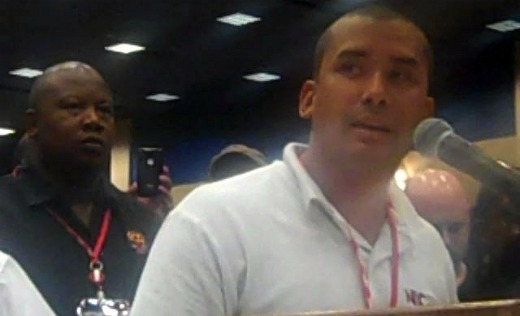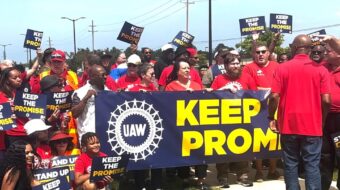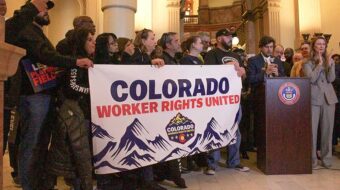
LAS VEGAS – A thin, pretty young woman from Canada with punky brown hair and a pierced lip speaks on the necessity for young workers to take charge. Jean Broughton, associated staffer at the Canadian Media Guild, speaks with a light Canadian accent on the urgency of preparing the next generation of union workers.
Currently, Broughton is working with her union making the preliminary steps in organizing young workers to take a more active role in their union – a policy that the Communications Workers of America (CWA) has undertaken and reinforced at their 73rd Convention this week.
With the ongoing economic crisis continuing to affect all sectors of the workforce, worldwide, the youth are not exempt. On the second day of the CWA convention here a committee addressed the issue of organizing young workers toward union jobs and union activism.
“I think that it’s absolutely critical for young workers to claim the union as their own. The union has, or it should have, a place for people to come together and empower themselves and learn about their rights,” Broughton said.
In 2009, young workers of the CWA started the Next Generation Committee with a motion for a resolution for young worker advocacy. Two years later, the committee presented a detailed resolution to get more young people involved in the union.
During the presentation of the committee’s report here, members spoke on organizing nontraditional workers, which includes freelancers, independent contractors and part-timers. The report said one-third of the U.S. workforce is now contingent labor.
According to the Bureau of Labor Statistics, in June the national unemployment rate in the U.S. was 9.2 percent. Yet according to the committee’s report, for people ages 20 to 24 it’s closer to 16 percent. But for young people of color, the unemployment rate is approximately 30 percent.
Jesse Abril, vice president of CWA Local 9511, from San Diego, helped start the Next Generation campaign and co-authored the Next Generation resolution. Abril’s determination to get young people involved is due partially to the fact that at 33 he’s still on the younger side of the age spectrum in the CWA. But more importantly it’s the logical conclusion that the youth are the ones that will inherit the union. Abril has already begun organizing young workers in San Diego. (See video of Abril’s convention speech at end of story.)
“I’m a very big advocate for the newest generation, the next generation,” Abril said. “I delegate a lot of work to the young people. And that’s what’s really important. Because a lot of people tend to babysit these new minds. And these men and women are extremely smart. They’re sharp. They’re bright. They have tons of energy. The problem is that the people that are within our rank and file right now are usually seasoned employees [that] have been there for over 25 years, so there’s this huge generation gap.”
There are many young people within the CWA, and specifically the locals in San Diego, ranging from the ages of 20 to 25, according to Abril.
“In the future what we’d like do is go to these job fairs and high schools and actually reach out to our company, AT&T, and have them supply us with tools to actually do an exhibit and bring the high schoolers in there, show them what kind of job it is, [that] this is a union job,” Abril said.
The committee’s report found that 58 percent of CWA young workers ages 18-35 are not involved in the union, but that most wanted to be more involved. It was solely an issue of not being asked.
Robert Longer, vice president and legislative political director for CWA Local 9421 from Sacramento, has been building a movement to organize young workers in his district.
“People really don’t understand what a union is, what it can do for you. Most of the people have never even been asked. If they’re asked to do something … then you see a spark kind of go off and then they start going ‘hey I can contribute to this,'” Longer said.
Longer and his local are following the Bay Area (specifically San Jose) model of organizing young workers through informal and unconventional methods. Recently, the Bay Area has seen success in youth activism in demonstrations and protests against Mayor Reed’s attempts to curb pensions for city workers.
Eric Lindberg, sporting a thick beard and pierced ears, is vice president of Local 9423 and helped start the Next Generation Bay Area organization, which has been leading the demonstrations.
Next Generation Bay Area was successful in pressuring the San Jose City Council in postponing cuts to public union workers’ pensions and setting up negotiations on the mayor’s memo that proposed cuts to city workers-all while dressing up as zombies under the slogan of the ‘working dead.’
“They want to stop raises for pretty much the next 30 years till the pension is self-sustaining. And that’s going to take 25 years, which means 25 years from now someone who gets hired on from the city will be making the same money as someone that’s working for the city right now. … If I was making the same wages as someone who did my job 25 years ago, I wouldn’t be able to live on that right now,” Lindberg said.
In addition to unions and young workers, many students support Next Generation Bay Area.
“We have multiple people from San Jose State, San Jose City College who are really active in our group. They show up to almost all of the rallies. They bring drums, people. We’re not fighting for just labor. We’re fighting for the rights of young workers, and the future of young workers and social justice, economic justice,” Lindberg said.
As the Next Generation Committee took the stage at the convention on the second day, Broughton, Lindberg and the rest of the committee read from the report. Lindberg offered a cogent metaphor for the current U.S. workforce and the economy.
“The economy is supposed to function like an escalator. You step on to the escalator and you step into a labor market and you go another level. There are people above you on the steps and when the escalator moves, the people in the higher positions step off the escalator and they retire. People in the middle move up. They take over those positions. And eventually they retire. You move up and you get to your final destination,” Lindberg said.
But, Lindberg continued, the cost of retirement and the rise of health care made it so that people in the middle of the escalator never moved up because people had to work longer and stay on the escalator longer.
“As companies downsize, people at the top and the middle got pushed down [and started] taking entry level jobs away from youth,” Lindberg said. “Someone threw a wrench in the gears.”
According to the report, “unionization rates in the United States have sunk to their lowest in history, at only 11.9% overall and 6.9% in the private sector. Youth unionization rates are two and a half times lower than those of workers aged 40-65.”
According to the committee’s report 30 percent of young workers in a union are more likely to get good health care; Young workers are also three times more likely to get a pension; and 27 percent are higher paid with young workers of the ages of 18 through 29 in a union get paid $1.75 dollar more an hour.
In times of harsh economic uncertainties, organizing the youth into better-paid jobs and social activism will prove rewarding.
To read “CWA: We’ve had no choice but to fight” in Spanish, click here.
Photo and video: CWA’s Jesse Abril speaks from convention floor in favor of the Next Generation report, July 12, Las Vegas, Nev. (Teresa Albano/PW)












Comments